They say… 
Best beer and travel writing award 2015, 2011 -- British Guild of Beer Writers Awards
Accredited Beer Sommelier
Writer of "Probably the best book about beer in London" - Londonist
"A necessity if you're a beer geek travelling to London town" - Beer Advocate
"A joy to read" - Roger Protz
"Very authoritative" - Tim Webb.
"One of the top beer writers in the UK" - Mark Dredge.
"A beer guru" - Popbitch.

|
Beer sellers: Beermania
ABV: 7.5%
Origin: Purnode, Hainaut, Wallonie
Website: www.st-feuillien.com, www.bocq.be
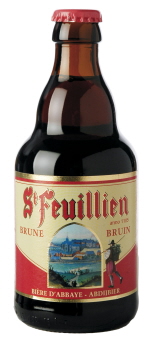 Du Bocq St Feuillien Brune Feuillien or Foillan was an Irish evangelist who, like numerous others, took up the viable 7th century lifestyle choice of wandering Europe preaching and setting up monasteries. Shortly after founding one at Fosse-la-Ville near Nivelles he was murdered by bandits — allegedly his decapitated head continued to preach after it had been flung into a pigsty. The Catholic Encyclopaedia says he died in the Zoniënwoud, the Forest of Soignes southeast of Brussels, but another claimed scene of the crime is Le Rœulx in the province of Hainuat. A Premonstatrensian abbey was founded in his name here in 1125, which quite likely brewed beer; it later succumbed to dissolution following the French revolution.
In 1873 the Friart family established a brewery in the town which through the 20th century developed a lucrative sideline in drinks distribution, so much so that in 1977 it pulled out of brewing altogether, commissioning its brands elsewhere. The mash tuns were stoked again by a new generation of Friarts in 1988 — the aim to bring all brewing back in house has not yet been achieved and some beers are still farmed out. When the Friarts moved into the abbey beer market, they naturally enough took the name of St Feuillien, and these brands have since become so prominent they renamed the both brewery and warehouse after them.
The brune is currently still one of those contract brews, emerging from du Bocq of Purnode, Namur, which brews for Corsendonk and others as well as making its own strong ales under the Gauloise brand. But despite its mixed origins it’s one of the better Belgian abbey browns. It’s a dark amber beer with a ruby tinge and a loose white head. A rich aroma has old books, yeast and chocolate, while a rich, sweetly fruity and malty palate yields mandarin, herbal angelica, glacé cherry and vermouth, drying into a rounded but firm, long and layered finish with plenty of fruit, some burnt roasty notes, dates, bonfire ash, a waft of hops and a sprinkling of salt.
Read more about this beer at ratebeer.com: http://www.ratebeer.com/beer/st-feuillien-brune/2405/
Beer sellers: Beermania
ABV: 6.5%
Origin: Ertvelde, Oost-Vlaanderen
Website: www.beermania.be/meaculpa, www.vansteenberge.com
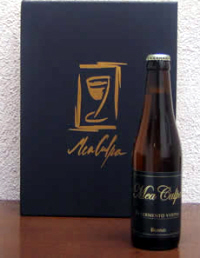 Van Steenberge Beermania Mea Culpa Nasser Eftekhari had been tasting, discussing and selling specialist Belgian beer in his comprehensive Beermania beer shop in Brussels for over 20 years when he commissioned his first own label brand in 2007. He was therefore well placed to know what would work with his customers. Perhaps unsurprisingly, he went for a blond medium strength very broadly abbey style beer. Its Latin name – Mea Culpa meaning ‘my fault’, a reference to a confession of sinfulness in the Roman mass – manages to evoke both monasticism and the sense of self-indulgent wickedness normally exploited in Belgium in branding stronger golden ales
The result is distinctive and unusual and doesn’t taste quite like any other beer. Some of this is due to the use of 10 different spices in a secret blend. Also supposed to be secret was the beer’s actual brewer, although this has since been leaked as Van Steenberge, the East Flanders brewery known for Gulden Draak and Bios brown ales as well as a long list of contract and own label brands.
 The Mea Culpa glass This cloudy blond beer has a thick white head and a slightly sourish aroma with complex spice, pale malt and vanilla notes. The palate is softly malty and apple-fresh with some phenols and subtle spicing with seed and herby notes. The finishes manages to be both drying and quenching with citrus, more vanilla and a late herbal touch. It won’t knock you down as an undiscovered classic, but it’s nonetheless a smooth, tasty and very drinkable beer with enough quirkiness to claim its own identity.
Nasser also put a lot of work into developing the beer’s own glass, a spectacular swan-necked creation in Bohemian crystal specially made in the Czech Republic. This rivals the Pauwel Kwak stirrup glass as Belgium’s most distinctive beer glass, but unlike the latter it’s a thing of beauty and elegance that doesn’t make you feel an idiot for drinking from it.
Read more about this beer at ratebeer.com: http://www.ratebeer.com/beer/beermania-mea-culpa/60038/
Beer sellers: Beermania
ABV: 6%
Origin: Beersel, Vlaams-Brabant, Vlaanderen
Website: www.3fonteinen.be
 3 Fonteinen Oude Kriek Traditional spontaneously fermented lambic beer doesn’t reach the consumer without being subjected to additional processes of maturation, blending and/or steeping with fruit to make it palatable. Though today’s better known lambic breweries generally carry out such processes themselves, there are opportunities for a third, non-brewing, party to get involved, as in the production of blended Scotch whisky or certain fortified wines. In the past there were numerous independent dealers and blenders of lambic in Pajottenland, including pubs that prided themselves on their own blends, particularly of g(u)euze, the flagship sparkling blend of old and new lambics. The term geuzestekerij, geuze tappery, is now used for independent blenders, though according to the authors of the newly updated LambicLand (2010), it was based on a coinage by Peter Crombecq, a founding father of modern Belgian beer appreciation, which places it no earlier than the 1970s.
The Debelder family started blending lambics in 1953 at their Beersel pub, De Drie Bronnen (‘The three springs’), and continued the practice when they moved to the Drie Fonteinen (‘Three fountains’) pub-restaurant in the same village. Over the decades Gaston Debelder and then his sons Guido and Armand built Drie Fonteinen’s reputation to the extent that it became one of best known Pajottenland lambic cafés, acquiring worldwide fame as enthusiasm for Belgian craft beer went global, with its bottled lambics available far beyond Beersel. In the 199os, concerned at the dwindling supplies of wholesale lambic, Armand took the decision to start brewing it himself, setting up a new company, AD Bieren, and the cachet of his 3 Fonteinen brands among international beer enthusiasts looked set to keep growing.
Then in May 2009 disaster struck: a thermostat in one of his temperature-controlled storehouses in nearby Halle failed over the weekend, ruining 50,000 litres of uninsured beer, worth €224,000, in the middle of its bottle conditioning process. Coming at a time when Armand was already in difficulties financing his brewing kit, this could have meant the end of AD Bieren, but in an impressive display of generosity, beer fans and brewers rallied round. 30 volunteers spent a Saturday pouring out all the bottles, worth a considerable amount even empty, so the contents — drinkable but not properly matured to the brewery’s high standards — could be shipped to the Biercée distillery in Thuin for turning into the world’s first lambic eau-de-vie. Named Armand’Spirit, it was largely pre-sold even before the stills fired up.
Now, while a return to brewing is unlikely in the forseeable future, 3 Fonteinen continues to blend using its own old stocks and bought-in lambics, and still commissions non-lambic beers from De Proef under the Beersel brand. Its signature products remain its Oude Geuze and Oude Kriek, its versions of the two legally recognised and protected lambic styles. The base lambic is made from 40% unmalted wheat alongside barley malt with properly aged hops as standard for the style; the kriek contains 35% genuine sour kriek cherrries.
My tasting notes for the kriek are for a 2004 bottling I bought in Liège, back when 3 Fonteinen was brewing, and finally opened almost four years later, but still well short of its best before date of 2014. The beer poured a proper cherry red with a foamy pink head that soon declined. There were cherry stones, lanolin and fruity sharpness in a slightly salty aroma, and an absolutely dry and clean tart palate softened by subtle fruit with hints of lemon juice and apple. The swallow felt like it had rinsed my teeth, setting up a tart finish with subtle almond, cherry and blackcurrant notes. Overall this was an extremely elegant beer, dead dry but well-balanced and not as challenging as some examples of this fascinating family of beers.
Update May 2012: Thanks to particularly strong sales since the accident, 3 Fonteinen has been able to restore its brewing capacity earlier than expected. A new brewery is being installed over summer 2012 and should be in operation for the 2012/13 brewing season.
Read more about this beer at ratebeer.com: http://www.ratebeer.com/beer/3-fonteinen-oude-kriek/11175/
First published in Beers of the World April 2008
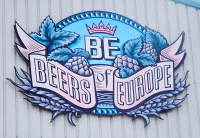 Beers of Europe The UK’s biggest range of international beers, comprising over 1,700 lines, can be found at a shop and warehouse in an industrial unit on the unpromisingly named Garage Lane, Setchey, just off the A10 on the rural southern outskirts of Kings Lynn. Surprising, perhaps, since the old port of Lynn, while pretty and historic, is hardly a buzzing metropolis. But if you offer a service like Derek Clark, his wife Carol and sons Jason and Daniel, the dedicated connoisseurs will come to you.
The area does have its other attractions, with the Royal residence of Sandringham just up the road and the beautiful Norfolk Coast and Broads close at hand, so some customers combine beer shopping with a leisure break. But others regularly trek from London, Birmingham or from even further afield, such as the two Californian abbey beer devotees in search of Tongerlo Dubbel.
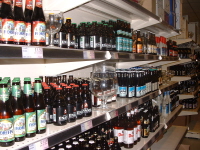 Belgian beer shelves in Beers of Europe “They emailed me the day beforehand to check I had it in stock,” says Derek. “Then they flew to Heathrow, hired a car, came straight here, bought a case, spent a day on the coast and flew home. They worked for the airline so they got cheap tickets.”
 Seriously big bottles at Beers of Europe Though born in London, Derek grew up in the area and first worked designing TV aerials for the family firm, which happened to have associate offices in Belgium and Bavaria. While visiting these Derek got a taste for the local beers, particularly the darker examples, and thought they should be available back home. The Clarks first planned a wholesale business but when this didn’t work went direct to the customer, opening Beers of Europe in 2000, just as both internet shopping and interest in speciality beers were growing in Britain.
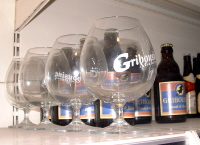 Don't forget the glasses: Beers of Europe Today a third of the beers are Belgian, and about a sixth German, including some that rarely travel beyond their home town. The German collection is a particular strength, with rarities such as unfiltered lagers, and even impresses German visitors delighted to find beers impossible to obtain at home thanks to their notoriously regionalised beer market. Of the rest, a third is British, including a good range from East Anglia, and the rest genuinely international despite the company name. “If it’s unusual, even if I can only sell a case every six months, I’ll buy it,” says Derek. Glassware, fine ciders and unusual wines and spirits complete the range.
Expansion is planned, and there’s talk of adding a bar and perhaps even a brewery. Internet and mail order are a core part of the business, but Derek insists the walk-in shop plays a critical role: you sense face-to-face contact is a big part of his job satisfaction. “Our customers are nice, honest people who appreciate the good things in life,” he says. I’ll drink to that.
Fact file
 - Beers of Europe
Address: Garage Lane, Setchey, King’s Lynn PE33 0BE
Phone: +44 (0)1553 812000
Web: www.beersofeurope.co.uk
Hours: 0900-1800 Monday-Saturday, 1000-1600 Sunday
Drink in? No
Mail order: Yes, UK only
Manager’s favourites: Weltenburger Asam Bock, Peroni Gran Riserva, Sarah Hughes Dark Ruby
Beer picks
Five dark beers of Europe
- Achouffe McChouffe 8.5%, Achouffe, Luxembourg, Belgium. Strong but drinkable Scottish-inspired speciality with burnt twig and flower aroma, fruity herby palate and sweetish lightly roast malt finish.
- Budweiser Budvar Dark (tmavý ležák) 4.7%, České Budějovice, South Bohemia, Czech Republic. Easy drinking malty dark lager with caramel and gently smoky cigar notes from world-class brewery.
- Koningshoeven La Trappe Dubbel 6.5%, Berkel, North Brabant, Netherlands. Chestnut ale from the Dutch Trappist brewery, with malty dusty book aroma, aged port and candy on palate and mint chocolate finish.
- Tipples Hanged Monk 3.8%, Acle, Norfolk, England. Bottled conditioned dark mild with blackcurrant liquorice and cola aroma, pastilley malted mik palate and lightly dry smooth finish with mineral notes.
- Weltenburger Kloster Asam Bock 6.9%, Kelheim, Bavaria, Germany. Outstanding reddish-brown strong monastic lager, with toffeeish aroma, firm but soft toasty palate and nuts and oaked wine in rich malty finish.
 Weltenburger Kloster Asam Bock Beer sellers: Beers of Europe
ABV: 6.9%
Origin: Kelheim, Bayern, Germany
Website: www.weltenburger.de
The Low Countries aren’t the only part of the world where monks mix with mash tuns: the German-speaking countries too have their brewing brothers, or at least breweries located in working monastery premises. Weltenburger Kloster, a Benedictine abbey on a scenic peninsula of the river Donau, the Donaudurchbruch, near Kelheim in Lower Bavaria, dates its founding to 620 and claims to be the oldest monastery in Bavaria, though monastic life was suspended during the secularisation of Bavaria between 1803-42. Its brewery also claims to be the world’s oldest established monastery brewery, known to have operated since 1050 — almost a thousand years.
The abbey is particularly celebrated for its spectacular late baroque church, created between 1716-39 by architect and sculptor Cosmas Damian Asam, assisted by his brother Egid Quirin. Asam commemorated by the brewery with Asam Bock, an outstanding dark bockbier that’s easily one of the best of its style.
It’s a very deep reddish chestnut with a thick, fine yellow head and a nutty, malty toffeeish aroma with a faint hint of estery banana. A fresh, soft, toasty and slightly winy malt palate has nutty cherry notes, hops, and a slight acidic tangy balancing the biscuit. The long, sappy and vinous finish is rich with nutty malt, a little chocolate and a dab of oak.
Read more about this beer at ratebeer.com: http://www.ratebeer.com/beer/weltenburger-kloster-asam-bock/4025/
Beer sellers: Beers of Europe
ABV: 6.5%
Origin: Berkel-Enschot, Noord-Brabant, Netherlands
Website: www.latrappe.nl
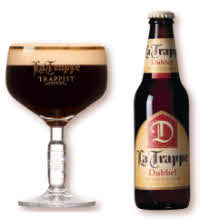 Koningshoeven La Trappe Dubbel The only official Trappist brewery outside Belgium is operated by the secular Bavaria brewery in partnership with the brothers of the Abdij Onze Lieve Vrouw van Koningshoeven near Tilburg — for more background see the review of La Trappe Blonde. These days the monastery brews a somewhat uncharacteristic range for a Trappist brewery, but retains at its core a trio of traditional monastic ales — this dubbel, a tripel and a noteworthy extra strong quadrupel. Interestingly, these date only from 1980 — back in 1884, brewery founder Brother Romaldus opted for a cold fermenting lager plant, then a rare beast in North Brabant. Nearly a century later, when the brothers brought the brewery back under their control after the ending of a partnership with Artois (now AB-InBev), lager brewing finally ended and the Trappe brand was developed for a range of products more in keeping with what the beer world generally expects from a Trappist brewery.
The dubbel, created from pale and coloured barley malts, caramel, candy sugar and German hops, isn’t the top choice in the style but is certainly a decent example, notably improved in recent years. A red-tinged chestnut colour with a thick yellowy head, it tempts with a malty fruity aroma with a waft of nuts and dusty books. The palate is thinnish for the style but nicely malty, with roast nuts, candy and a port-like note. A light swallow leads to a pleasant dark fruit finish with quite firm roast and light hops, and a note of plain chocolate and mint.
Read more about this beer at ratebeer.com: http://www.ratebeer.com/beer/la-trappe-dubbel/4563/
Beer sellers: Beers of Europe
ABV: 4.7%
Origin: České Budějovice, Jihočeský kraj, Czech Republic
Website: www.budvar.cz, www.budweiserbudvar.co.uk
 Budějovický Budvar tmavý ležák / Dark Lager Alongside Plzeňský Prazdroj (Pilsner Urquell), Budvar was already a famous Czech name in international beer circles before the Velvet Revolution, thanks in part to the international currency of the term Budweiser — meaning ‘from Budweis’, the German name for České Budějovice — for a quality lager. This mixed blessing had also provided the pretext for St Louis brewer Anheuser Busch (now part of AB-InBev) to drag the South Bohemian brewery through the international courts for alleged trademark infringement. As a result Budvar is now obliged to use the ugly alias Czechvar in the USA and some other markets, despite actually being Budweiser in literal fact.
Still, Budvar’s strength rests on far greater foundations than a claim to a historic name. One of the better supported breweries during the Stalinist period, it’s flourished since 1989, yet remains for the time being state owned — it’s been permanently on the brink of privatisation for a while, but perhaps the example of what happened to fellow icon Plzeňský Prazdroj when it was absorbed by SAB-Miller has helped keep it in public hands. Its golden 12° lager, for decades its only product, remains a world classic.
In recent years Budvar has expanded its brand portfolio, including the launch of this fine dark lager in 2004. Tmavý ležák, broadly comparable to German Dunkelbier, has long been a familiar minority style in the Czech lands, a remnant of brewing practice before the mid-19th century invention of clear, pale lager in Plzeň. But Budvar hadn’t traditionally offered one, so this was a self-conscious retro move playing on respect for the country’s brewing past. The stuff of myths — now there are some pubs in London making a big deal of selling a half-and-half cocktail of dark and pale draught Budvar as if it’s a centuries-old Czech tradition.
Brewed from Moravian Pilsner, Munich, caramel and roasted barley malt and Žatec hops, this is a mahogany beer with a bubbly fawn head. The mineral malt and caramel aroma has light cola nights and a touch of fruit, setting up a soft malty caramel palate with a light roast note and tingly hops. A clean mild dark malt finish emerges from a cleansing swallow, with lightly tangy, chocolatey hints. It’s a quiet but considered dark beer, not intensely flavoured but very pleasant and well-balanced.
Read more about this beer at ratebeer.com: http://www.ratebeer.com/beer/budweiser-budvar-tmavy-lezak-dark-lager/36339/
Beer sellers: Beers of Europe
ABV: 8.5%
Origin: Achouffe, Luxembourg, Wallonie
Website: www.achouffe.be
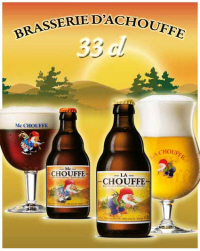 Achouffe La Chouffe and Mc Chouffe Today the Achouffe brewery is one of the most internationally familiar of Belgian micros, with its cheerful trademark “chouffes” (gnomes) grinning out from beer store shelves in more than 20 countries. All this must have seemed unthinkable back in 1982 when Pierre Gobron and Chris Bauweraerts set up shop on a shoestring in the small village of Achouffe, near Houffalize in Belgian Luxembourg, deep in the Ardennes. But Pierre and Chris knew a thing or two about marketing – the rosy-cheeked chouffe, drawn from local folklore, formed the core of a regional brand identity that now encompasses a fan club and an annual event, La Grande Choufferie, based at the well-regarded brewery tap in the village.
The still tiny brewery was well positioned to benefit from the growing international interest in Belgian beer that developed from the late 1980s, and it became a pioneer exporter, with the Dutch and the Québecois the first to succumb to the chouffe’s charms. In 2006 the business was sold to expanding Belgian new national Duvel-Moortgat, though so far little has changed except improved access to market. For years the brewery insisted on selling nearly all its beers, including this one, in 750ml bottles, but most have since been made available in 330ml sizes too.
Besides La Chouffe, the flagship blond ale with which it launched, Achouffe has long offered a second regular beer, the vaguely Scottish-accented Mc Chouffe, originally inspired by a Scottish friend of the brewers, though it also reflects a significant strand in Belgian taste — there has long been a significant market in the country for “wee heavy” style beers, some of which were brewed in Scotland especially for Belgium. Mc Chouffe stretches the definition a bit but the influence is discernible.
It’s a cloudy brown bottle conditioned beer with a good foam head and a moderate aroma of burnt twigs, fruit and flowers. A quite fizzy but rich palate has grape-like fruit, a herbal coriander touch, and some sharpish roast which dries out the swallow. The finish turns slightly sweeter with ashy roast tones percolating to the surface through rich malt, leaving a lingering tang.
Some serious beer fans can get a bit snobby about Achouffe, but it’s a little unfair. Like its golden older brother, Mc Chouffe isn’t an overwhelmingly brilliant world beater, and isn’t specially authentic to its style. However it’s an enjoyable, easy drinking craft-brewed ale with its own distinctive character, and there’s no shame in that.
Read more about this beer at ratebeer.com: http://www.ratebeer.com/beer/mc-chouffe/1615/
Top Tastings 2010 (Oldgott Barique)
ABV: 5.2% and 12.6%
Origin: Praha 1, Hlavní město Praha, Czech Republic
Website: www.umedvidku.cz
 U Medvidků, Praha 1 The Czech lands gave birth to the world’s most ubiquitous brewing style and the modern day Czech Republic is still one of the great beer nations, so it’s rather remiss of me to wait almost a year before finally adding a Czech brewery to this ste. Sadly only a severely limited range of Czech beers is available in the UK, so it’s taken a long overdue trip to Prague to furnish some recent tasting notes of the more interesting stuff.
And more interesting stuff there definitely is besides the obvious “heritage” pale lagers. Following a rapacious period of consolidation and globalisation ushered in by the restoration of the market, pockets of independent thinking are developing, and a new craft brewing culture is starting to emerge that both takes pride in indigenous brewing traditions and is open to innovation, and influence from abroad.
The microbrewery at Medvidků, on the edge of the historic Staré Město (Old Town) district right in the city centre, is a great example. U Medvidků (‘At the [sign of the] Little Bears’) is a classic sprawling Prague pub and hotel with half a millennium’s worth of history behind it, long appreciated by discerning drinkers as a more amenable and less tourist-saturated alternative to slightly better known drinking holes like U Fleků and U Zlatého tygra. For years it stocked only one beer, the standard draught 12° golden lager from Budějovický Budvar, which it was renowned for keeping exceptionally well. Then on 17 November 2004, the 15th anniversary of the Velvet Revolution, onsite brewing was revived for the first time since 1895 using a 250l-capacity microbrewery newly installed in the former malthouse. Wisely the brewers chose not to challenge the popularity of Budvar but instead developed a range of their own specialities, traditionally lagered in wooden barrels and served unpasteurised and unfiltered.
Oldgott Barique, the regular beer, is an amber polotmavý or ‘half-dark’ lager, a traditional style near extinct by the turn of the millennium and since rejuvenated, though still a relatively rare speciality. Its closeness to the more widely known Vienna style associated with Anton Dreher reflects the region’s history as a former province of Austria-Hungary.
This example is a cloudy amber with a thick nutmeggy light beige head, served at the pub in a chunky multifaceted glass mug. A fresh, slightly yeasty aroma has lightly tart strawberry notes. The palate is dry-sweet and spicy with a slight touch of burnt wood, a hint of dates and strawberries and a bite of herbal hops over very smooth and generous toffeeish malt, with perhaps a fleeting touch of mint. The dry, spicy smack persists in a quite rooty, hoppy and bittering finish with tart plummy notes softened by yeasty malt. It’s a striking, unusual and very distinctive beer.
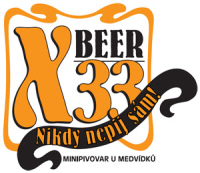 U Medvidků X Beer 33 Better still is X Beer 33, an extraordinary strong lager brewed once a month from Pilsner and caramel barley malts at an original gravity of over 33° Plato and matured for up to a year in oak barrels using a special yeast. It’s also available bottled, but I sampled the draught version, which arrived at my table a deep hazy ruby-brown with a thick beige head. A tannic, grapy, oaky aroma has some fresh fruity esters, heralding a big bodied grapy-fruity palate, notably sweet but with a plummy, tannic, balsamic edge, Rodenbach-like sour tones and complex spiced orange liqueur notes. For all the complexity, there’s a soft, clean character that identifies the beer as a lager rather than an ale. The finish is long, complex and marmaladey, with a little powdery dry pursing hops and a late splash of vanilla. Of course it’s by no means the strongest beer in the world, as its publicity still claims, but it’s certainly among the most remarkable.
Read more about this beer at ratebeer.com: http://www.ratebeer.com/beer/u-medvidk367-x33-beer/58029/
ABV: 7.7%
Origin: Ashford-in-the-Water, Derbyshire, England
Website: www.thornbridgebrewery.co.uk
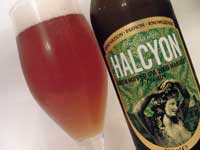 Thornbridge Halcyon Green Hopped IPA. Pic: Mark Dredge, www.pencilandspoon.com Peak District-based Thornbridge continues to demonstrate its world class credentials with its latest batch of special bottles. This limited edition of Halcyon, already an impressive India Pale Ale, was brewed during last year’s hop harvest and dosed with “massive amounts of freshly picked Target hops from Mr Capper’s farm in Herefordshire”. Target is not a variety commonly linked with the phrase “massive amounts” in the brewers’ vocabulary but it certainly makes the best of its turn in the spotlight here.
For those unfamiliar with green hopped beers, unlike most beers which use dry whole hops, pellets or extract, these use fresh hops straight from the farm. The result, well demonstrated here, should be a definite hop character accompanied by a freshness and slightly vegetal quality that’s notably distinct from conventional hopping.
This pale gold hop-hazed beer pours with a thick off-white head, exuding a piny, resiny and peachy aroma with slightly sulphurous and lightly honeyed notes. There’s peach and strawberry fruit up front on the palate but intense piny, resiny hop flavours soon develop on the tongue, although with a very smooth and creamy touch. A clean, lightly malty finish stays smooth while developing an assertive lettucey bitterness.
Thornbridge has flourished as one of Britain’s most innovative and consistent craft breweries under brewery manager Kelly Ryan. Kelly is about to return to his native New Zealand. Beer Culture wishes him the very best of luck and looks forward to sampling the great beers he’s sure to continue brewing in the southern hemisphere. He’ll be a hard act to follow in the northern one.
Read more about this beer at ratebeer.com: http://www.ratebeer.com/beer/thornbridge-halcyon/84956/
|
Cask  This pioneering new book explains what makes cask beer so special, and explores its past, present and future. Order now from CAMRA Books. Read more here. This pioneering new book explains what makes cask beer so special, and explores its past, present and future. Order now from CAMRA Books. Read more here.
London’s Best Beer  The fully updated 3rd edition of my essential award-winning guide to London’s vibrant beer scene is available now from CAMRA Books. Read more here. The fully updated 3rd edition of my essential award-winning guide to London’s vibrant beer scene is available now from CAMRA Books. Read more here.
|




















